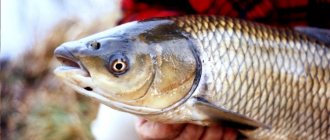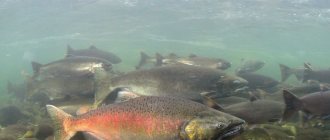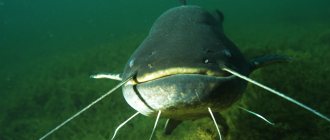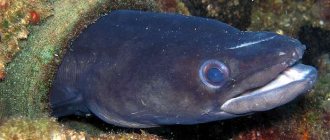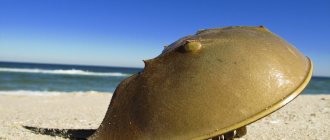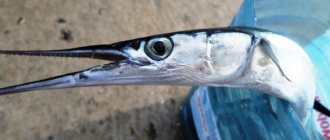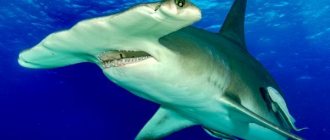- Wild animals
- >>
- Fish
Grouper fish is one of the most interesting and unusual marine inhabitants. Today, scientists count about a hundred species of grouper. Some of them are real giants, weighing half a ton and up to three meters long. There are also species whose body size does not exceed several tens of centimeters. Different representatives of the species have not only different sizes, but also appearance and lifestyle. This fish is highly valued among gourmets due to its unusual, delicate taste and special aroma. In addition, its meat is practically devoid of calories and enriched with vitamins and minerals. The fish is found under the name mirow or black.
Origin of the species and description
Photo: Grouper
Grouper is classified into the phylum Chordata, class ray-finned fish, order Perciformes, family rock perch, genus grouper.
The lifestyle, features of vital activity and stages of evolution of the rock perch have not been thoroughly studied. However, scientists and researchers have determined that these representatives of marine flora and fauna appeared about five million years ago. The appearance of the Isthmus of Panama about 3 million years ago contributed to the division of fish into two subspecies due to the division of the population territorially.
Video: Grouper
In the process of adapting to new conditions of existence and in the process of evolution, the grouper has learned to change its body shape and color in order to camouflage itself and remain unnoticed in the event of approaching danger. Also, in the process of evolution, the shape and structure of teeth have changed somewhat. They are arranged in several rows and are somewhat reduced in comparison with the original size.
Scientists note that grouper is one of those representatives of marine flora and fauna that have practically not changed since their appearance. In the process of distribution, fish were divided into many subspecies, each of which acquired distinctive external characteristics, characteristic features of behavior and lifestyle.
Appearance and features
Photo: Grouper fish
Regardless of the subspecies, size and region of habitat, all groupers are characterized by certain features that unite them.
Characteristics of groupers:
- large, massive body, somewhat flattened laterally;
- gill covers with spines;
- huge oral cavity;
- the presence of one spiny fin on the surface of the back;
- the presence of three spines on the anal fin;
- the teeth are short and very sharp, arranged in several rows.
This type of perch is called stone perch because of its external similarity to bottom boulders. This is not even explained by the huge size of the body, but by the specific coloring, which is very similar to rocks, stones and coral reefs. There are many dots, circles, stripes, etc. on the body of fish.
Fish also has a number of specific characteristics that distinguish it from other representatives of marine flora and fauna.
Features:
- small, round eyes;
- a huge, wide head part, against which the eyes seem especially small and insignificant;
- Almost all grouper individuals are hermaphrodites. They have an ovary to produce eggs and a testis to produce the cells that fertilize them;
- Body sizes can reach from 10 centimeters to three meters.
Interesting fact: Fish are endowed with the ability to change color and body shape for the purpose of camouflage.
The body weight of one adult individual depends on its size and ranges from 10-20 to 350-400 kilograms. The color can be very diverse, from bright, rich red to mottled, gray or brown. It depends on the region where the predator lives. The oral cavity is very large, slightly pushed forward. It is framed by skin growths that give the shape of pronounced lips.
Ancient fish asp
A representative of a special species of Aspius Aspius with red ventral fins is the asp fish. Most of all it is found in water bodies of Western Asia. It lives in large lakes and medium-sized rivers. It is also often found in water bodies of central Europe flowing into the Black, Azov, and Baltic Seas.
In its family, this redfin fish is the largest. The standard weight of an adult is from 2 to 4 kg. Large specimens reach 8 kg in weight. Even 15-kilogram asps were caught in the Moscow River. This fish has many chewing teeth, small scales, small eyes, and a pointed head shape. The asp has a wide back, shimmering with gray and blue shades. The belly of the fish is white. The eyes are yellow. But the fins are exactly the color we are interested in – gray with red tints.
The ancient fish asp feeds exclusively during the day, entering shallow places. Sometimes on the surface of the water you can see its dorsal fin, reminiscent of a shark. The asp swims at high speed, so it creates waves in the water. A special dish for this predator is small fish. Seeing a school of this fish nearby, an asp can perform real pirouettes in the air. In the early morning you can often hear loud splashes from its tail hitting the water. This is how he stuns his prey. Sometimes he catches fish with his mouth.
Asp is a rather rare fish; it is not grown for industrial purposes. Only occasionally will this beauty be caught in a fisherman’s catch along with other fish. Even online he rarely comes across it, because when he sees it, he immediately turns in the opposite direction. And it’s just very difficult to catch this fish with a fishing rod.
The asp spawns with the onset of winter, as soon as the first frosts begin. If someone manages to catch this beautiful fish, it will be a good addition to the fisherman's collection.
Where does the grouper live?
Photo: Giant grouper
The vast majority of grouper species live in marine waters. All of them are heat-loving fish and choose tropical or subtropical waters. Only two of all described species are found in Russia.
Geographical regions of grouper habitat:
- South African Coast Bay;
- Red sea;
- Algoa;
- Greenland;
- coast of Panama City;
- Pacific Ocean;
- Indian Ocean;
- Atlantic Ocean;
- Southern coast of Japan;
- coast of America;
- coast of the Hawaiian Islands.
The fish can live at various depths from 15 to 50 meters. A prerequisite for the habitat of groupers is the relief of the bottom, which is necessary to provide shelter. These can be sea stones, boulders, thickets of coral reefs, sunken ships, deep caves, rocks, etc. Fish from regions with sandy and excessively muddy bottoms do not tolerate it.
Fish of this species are not characterized by a tendency to migrate. They spend most of their lives in a certain territory. In addition, they are very passionate about its protection of its habitat. They can easily and without hesitation engage in fights with opponents whose body size and strength can significantly exceed their own dimensions. A person can also be in danger if he gets too close to a predator’s hideout. A predator with lightning speed, with an open mouth, attacks from its shelter an object that poses a danger to it. Particularly large individuals can even swallow a person.
Now you know where grouper fish are found. Let's find out what we eat.
The principle of hunting
The predator usually starts looking for prey during twilight or at night. It waits for prey in ambush, masquerading as surrounding stones, plants, and the bottom.
Pisces are lazy in hunting, so they rarely start a race. Sea creatures swimming past the ambush become food. The grouper quickly emerges from its hiding place and swallows its prey.
What does grouper eat?
Photo: Atlantic grouper
Rock perch is a predatory fish. He is absolutely not picky about food and eats everything he can swallow. The main condition is that the prey must fit into the predator’s mouth. The grouper is a real hunter. He can wait for his prey for a long time, being in cover. When the prey is as close as possible, the predator simply attacks it with its mouth open.
If the prey turns out to be agile and fast, and the rock perch fails to catch it, it easily starts a long chase. A case is described when a huge representative of this species swallowed whole a one and a half meter shark, which fell off a fisherman’s hook. The predator chased the shark for quite a long time, and when it broke away, it instantly swallowed it. With its mouth wide open, the rock bass has a truly intimidating appearance. Therefore, individuals that are large in size pose a serious danger. Divers are advised not to get too close to them.
The grouper has one unique ability - it can hunt in alliance with a moray eel. When a predator feels that its prey is out of reach, it calls its companion for help. To do this, a huge predator approaches the moray eel’s shelter and shakes its head from side to side several times. Most often, the moray eel responds and a joint hunt begins. The moray swims into the shelter where the victim is hiding and drives it out of there. In some cases, the stone perch's partner does not mind feeding herself.
In most cases, grouper prefers to hunt on its own and not share with anyone. Rock perch have their own taste preferences.
What does grouper eat:
- lobsters;
- crabs;
- shellfish;
- stingrays;
- small sea turtles.
Features of character and lifestyle
Photo: Grouper fish
Grouper is characterized by territoriality. They live in the same territory almost throughout their lives, and they do not tolerate the appearance of rivals or other inhabitants on it. They see rivals not only in humans or representatives of other species of marine flora and fauna, but also in their relatives. When the slightest danger appears, the predator swims out of its hiding place with its mouth open. In doing so, it can cause serious injury. The attacks can continue repeatedly. In the process of defending their territory, predators can fight with rivals that are several times larger than them in size and power.
Groupers tend to spend most of their time in cover. As such, predators most often choose coral reefs and sunken ships. Fish can leave their chosen shelter only when they need to give chase or call a moray eel for help. In addition to moray eels, groupers often try to stay close to pelicans. Birds love to feast on fish. Attacking schools of fish, they snatch their prey. The fish, in turn, rush into the scattered fish, and the grouper catches individuals that lag behind the school.
Despite the fact that predators are exclusively heat-loving fish and live in salty ocean waters, there are exception species. They are found in fresh sea water. Groupers tend to develop quite high speeds - up to 25-30 km/h. This ability significantly increases the chance of a successful hunt.
Methods for catching rudd: equipment
You can catch rudd in a variety of ways; the most popular and effective methods are discussed in detail below:
Fishing with a float rod is one of the most common options and is especially suitable for beginners. To catch rudd, you can use both fly rods and match or Bolognese varieties for making long casts. This type of fishing is widespread due to its main advantage – high speed. The bite occurs immediately shortly after the cast has been completed, and it does not take much time to catch the prey.
Fishing with sbirulino or bombarda involves using a special type of water-filled float while fishing. The main advantage of this method is the ability to make the longest casts without sinking the float.
Fishing with feeders is less common, this is due to the fact that rudd tries not to descend to significant depths
For this reason, feeder fishing is most effective in the autumn, as well as in summer or autumn, if the weather is cool for a long period with significant precipitation. Even during such periods, it is not recommended to go to a depth below 1.5 m, and in order to in order to get a significant catch, the place will need to be pre-fed. At the same time, it is important to attract the attention of the fish that is nearby, but not to overfeed it, so after some time it is recommended to replace the feeder with bait with a less voluminous option. Otherwise, the technique and features of fishing using feeders do not differ from other methods. I usually practice fishing with a spinning rod in the spring, but it can also be a very effective option for summer fishing. It is recommended to use small-sized flies with retractable leads, which will become the main assistants when catching rudd in shallow water
You can also use small-sized edible twisters, zero spinners and the same small-sized wobblers.
Social structure and reproduction
Photo: Grouper
Puberty occurs at the age of 2-3 years. Reproduction occurs with the help of eggs. Fish most often deposit it in their chosen shelters. After some time, they fertilize it, and subsequently many fry appear. They are quite viable. Their size and color range are very diverse depending on the subspecies and region of habitat.
Interesting fact: The sea predator is a hermaphrodite. This means that each adult has both an ovary to produce eggs and a gland to produce sperm. In this regard, one individual can produce eggs and fertilize them themselves. All individuals are considered females after birth. However, once they reach sexual maturity, they become males.
It would seem that this is an ideal option for restoring the population size and independent reproduction. However, after several generations, the genome degenerates, so fish of this species need to mix with other species.
The average life expectancy of a representative of this species of marine predator is 30-35 years. Life expectancy directly depends on the species and region of habitat. Giant individuals live in natural conditions for about 70-80 years. Small species that can be bred at home in an aquarium live no more than 10 years.
Natural enemies of groupers
Photo: Giant grouper
Despite its power and fearlessness, the rock bass does not belong to the category of apex predators. Subspecies that are particularly large in size have virtually no enemies. Subspecies, which are characterized by smaller sizes, have quite a lot of enemies in natural habitats.
Natural enemies of fish:
- sharks;
- killer whales;
- moray eels;
- barracudas.
The main enemies of amazing representatives of marine flora and fauna are humans. As a result of his activities, the number of fish has been rapidly declining for almost ten years. This is due to the hunting of them in huge quantities. Poachers caught them not only for the purpose of material gain or as a source of food, but also simply for sport. The caught predator was simply used to make a stuffed animal, which served as a decoration or trophy.
Fish are very sensitive to changes in temperature or other characteristics of the waters of the world's oceans. That is why increasing pollution has a detrimental effect on the population of many representatives of marine flora and fauna.
Useful qualities
Grouper meat is dietary. It contains a huge number of useful elements:
- a lot of easily digestible protein;
- selenium, sodium, potassium, phosphorus, calcium;
- beneficial amino acids that accelerate metabolic processes and help saturate cells with oxygen;
- vitamins that improve the functioning of the central nervous system and maintain sugar at the required level.
Thanks to this composition, fillet improves the skin and prevents the occurrence of thyroid diseases. If you eat meat once a week, you can strengthen nerve fibers and the walls of blood vessels, get rid of bad cholesterol, and improve memory.
Population and species status
Photo: Grouper in the water
According to the analysis, scientists found that over the past decade, the rock bass population has declined by more than 80%. A number of reasons contribute to this.
Reasons for the decline in fish numbers:
- significant pollution of the world's oceans;
- depletion of flora and fauna, as a result of which the food supply is reduced;
- significant changes in climate and weather conditions.
All these factors together had a significant impact on the number of predators. There has been a decline in population and human activity. This is due to the increase in cost and growing demand for meat from young animals. It has incredibly tender and tasty meat, which has virtually no calories. Also, an important advantage of predator meat is its high content of vitamins and minerals.
Another significant reason for the decline in fish numbers is the huge number of fishermen and poachers who hunt for the desired prey for profit or pleasure. Representatives of this species are especially vulnerable during the breeding season, when they gather at river mouths. During this period, they gather in huge numbers in these places, and the fishermen know it.
Red
The red grouper fish grows up to 40-45 cm. The body is orange-scarlet, with turquoise splashes. Young individuals are lighter, mature ones are darker.
This variety is bred in an artificial environment. Caring for fish is quite simple and even beginner aquarists can do it.